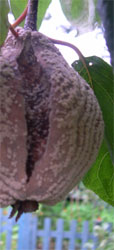Quince Jelly recipe (also works with Japonica quinces)
Posted by Fiona Nevile in Jam Jelly and Preserves | 163 comments Our friend Bunty gave us a Portuguese quince tree three years ago. Besides being very decorative, with dark branches and lazy, floppy leaves it produces the large firm fruit that make the tastiest jelly. Mature quince jelly (over six months old) turns a gorgeous amber colour.
Our friend Bunty gave us a Portuguese quince tree three years ago. Besides being very decorative, with dark branches and lazy, floppy leaves it produces the large firm fruit that make the tastiest jelly. Mature quince jelly (over six months old) turns a gorgeous amber colour.
The first year our tree produced one small quince. It bore three last year and this year suddenly came into its own. The crop would be at least ten. The fruit are quite big so there would be enough to make more than jelly. Anne Mary and I poured over her old recipe books. We could make quince marmalade or try our hand at Membrillo. Greedily I watched the quinces mature and fatten. Imagine my horror when I noticed that the fruit was splitting and rotting on the tree. The cause, I discovered, was lack of water.
It’s easy to forget trees in a drought. Especially when they have done well in their first couple of years. Old established trees have much deeper roots and can find water more easily than younger, smaller trees. It would have been so easy to take a spur from the drip watering system in the kitchen garden to the quince tree. I just didn’t think.
Our poor pear harvest was probably due to lack of water. I am going to give both trees a dressing of rich compost from our composter and cosset them this winter. Hopefully the bees will boost the germination of the blossom next spring. Our bees arrived just as the blossom was going over this year.
I managed to harvest two half quinces and they are simmering on the stove as I write this. The aroma from the simmering quinces is richly fruity. We’ll be lucky to make a couple of small jars. One for Anne Mary and one for us, as an inspiration for next year.
Quince Jelly recipe (this works well with Japonica quinces too)
Ingredients:
- 2 lbs of quinces
- 1 lemon (just the juice, sieved)
- white granulated sugar
- water to cover
Method:
- Wash and roughly chop the quinces (no need to peel, decore or depip) and place in a heavy bottomed saucepan.
- Barely cover with water. Bring to the boil and simmer gently with a lid on until soft. If the quinces are very firm this could take several hours. Check it every now and then and add more water if necessary.
- Pour the cooked fruit through sterilised muslin into a large clean bucket or bowl (how do I sterilise muslin/the jelly bag? See tips and tricks below). The muslin is often referred to as a “jelly bag”. We use tall buckets to catch the drips from the jelly bags. Rather than hang the bags (conventional method-between the legs of an upturned stool) I find it easier to line a large plastic sieve with the muslin. This clips neatly onto the top of a clean bucket. The sieve is covered with a clean tea cloth to protect against flies.
- Leave the jelly bag to drip overnight (or about 12 hours).
- Measure the juice the next day.
- Pour the juice into a deep heavy bottomed saucepan and add 1lb/454g of white granulated sugar for each 1pt/570ml of juice.
- Add the lemon juice.
- Heat the juice and sugar gently stirring from time to time, so as to make sure that that all the sugar has dissolved before bringing the liquid slowly to the boil.
- Continue to boil for about 10 minutes before testing for a set. This is called a rolling boil. Test every 3 to 5 minutes until setting point is reached. (What is testing for a set? See tips and tricks below). Tossing in a nugget of butter towards the end will reduce the frothing that can occur.
- When jelly has reached setting point pour into warm sterilised jars using a funnel and ladle. (How do I sterilise jars? See tips and tricks below).
- Cover immediately with plastic lined screw top lids or waxed disks and cellophane tops secured with a rubber band. If you don’t think that the jelly has set properly, you can reboil it the next day. The boiling reduces the water in the jelly. I have done this in the past. Ideally you should try for the right set the first time.
- Label when cold and store in a cool, dark place. Away from damp.
Tips and tricks:
- What is a jelly bag?
A jelly bag is traditionally a piece of muslin but it can be cheesecloth, an old thin tea cloth or even a pillowcase. The piece needs to be about 18″ square. When your fruit is cooked and ready to be put in the jelly bag, lay your cloth over a large bowl. Pour the fruit into the centre of the cloth and tie the four corners together so that they can be slung on a stick to drip over the bowl. Traditionally a stool is turned upside down, the stick is rested on the wood between the legs and the jelly bag hangs over the bowl. We experimented and now line a sieve with muslin, place it over a bucket and cover the lot with clean tea cloths (against the flies). - How do I sterilise muslin/the jelly bag?
Iron the clean jelly bag with a hot iron. This method will also sterilise tea cloths. - Jelly “set” or “setting point”?
Getting the right set can be tricky. I have tried using a jam thermometer but find it easier to use the following method.
Before you start to make the jelly, put a couple of plates in the fridge so that the warm jam can be drizzled onto a cold plate (when we make jam we often forget to return the plate to the fridge between tests, using two plates means that you have a spare cold plate). When testing for a set drizzle some jelly into the cold plateand return the plate to the fridge to cool for approx two minutes. It has set when you run your finger through it and leave a crinkly track mark. If after two minutes the cooled jam is too liquid, continue to boil the jelly, testing it every few minutes until you have the right set. The jelly is far more delicious if it is slightly runny. It does get firmer after a few months. - How do I sterilise the jars and lids?
We collect jars all year round for our jelly, chutney and jam making sessions. I try to soak off labels and store the clean jars and metal plastic coated screw-top lids in an accessible place. The sterilising method that we use is simple. Just before making the jam, I quickly wash and rinse the jars and place them upside down in a cold oven. Set the temperature to 160c/140c for fan assisted. When the oven has reached the right temperature I turn off the heat. The jars will stay warm for quite a while. I only use plastic lined lids for preserves as the all-metal lids can go rusty. I boil these for five minutes in water to sterilise them. If I use Le Parfait jars, I do the same with the rubber rings.
Leave a reply






I spent all yesterday cutting and boiling quinces for jelly. Only to discover that the fruit when boiling has removed the non stick coating from the saucepan. I am left wondering if this will effect the juice and harm anyone eating the finished product. My husband pointed out that they would not put any dangerous non stick coating on the saucepan. They are ftrom America and called
Commercial Aluminum Cookware Company. Toledo Ohio. U.S.A. not sure if to continue or throw all the juice away. After all my hard work it seems a pity not to continue. Joanne. Thanks for the recipe anyway.
Hi Maria,
I will photograph the fruit on my own tree tomorrow to add to the reference on this site.
Looking forward to hearing how you got on.
That’s the ones I have………
I’ve bought some lovely new jars – as I made so much damson cheese this year I’ve run out – so I’ll be boiling tomorrow
I’ll tell you what the results are like
Many thanks
Maria
Hi Maria,
Quinces are great for jelly or membrillo (if you have them). Here is a link to quinces on a tree http://www3.unifi.it/ueresgen29/ph6-2.htm
I hope that this helps.
It would be great to hear how you get on!
Hi,
I’ve got some really strange fruit, which are like a hard pear – yellow green and very hard – I am presuming they are the fabled quince everyone is talking about and there is a tree full – does anyone have a picture of one for identification as I am a soft fruit jam maker by preference, but would like to try my hand at quince jelly if I have correctly identified the fruit? I have the japonica version in profusion as well, so will be able to make either, but it would be nice to try them side by side.
Maria
Hi LizO,
I have answered your question on the tangy apple sauce recipe post. You could try canning in small Le Parfait jars as I haven’t done this with apple sauce, I don™t know how it would work out. We have instructions on canning at of the end our Belgian Pears post, in the tricks and tips section.
hi
just to let you know that i made the quince jelly again – so easy and very successful that i now have some to give away to the lovely people who have given me fruit
Am moving on to apples now – there will be lots of apple sauce in my freezer for the coming seasons. I presume that it will need freezing and wont keep for very long in jars? Can you confirm please
LizO :o)
Hi LizO,
Thanks so much for taking the trouble to leave a comment. Glad the recipe worked well for you. Quince jelly is superb.
I love making jam and jelly. I find it very soothing.
I followed this recipe with some quinces that I was given, and having left them straining through a jelly bag overnight. The result is absolutely delicious and will go well with both meats and cheeses because it has a delightfully sweet/sharp flavour.
Thank you again for the support of the Cottage Smallholder – I have definitely taken to good old jam and jelly making thanks to your support.
The mad hedgerow collector, LizO :o)
isn’t it the portuguese who gave us the original ‘marmalade’ which was made from quinces? i’ve made quince jelly, using the hard, japonica variety. it was very tangy, not unlike marmalade, and worked perfectly with good roast pork or sausages.